
Though you may not have noticed, you have likely heard or used quite a few metaphors today. Perhaps you’ve said someone has a “heart of gold” or conversely, a “heart of stone” or called a lively child “a real firecracker!”
A metaphor makes a direct comparison between two things that are generally not related or similar, but share a specific quality or characteristic that is emphasized through the comparison.
While we may learn about metaphor most directly through poetry and literature, metaphors aren’t just for artists. They add color and carry meaning even in our everyday language.
What Is a Metaphor?
A metaphor is a type of figurative language. It is a figure of speech used to convey a message that goes beyond the literal meaning of their words.
Figures of speech are not intended to be taken literally.
A person can’t have a heart of gold or stone, and a child is a human, not an explosive!

So what’s the point of the comparison then? The point is to go beyond literal meanings.
Gold is precious; it’s pure and valuable. A person with a heart of gold is sincere and kind—a purely good person who adds value to others’ experiences.
Stone is cold and hard. A person with a heart of stone shows no emotional tenderness or empathy—no softness or warmth in their personalities.
A firecracker is full of energy and vibrancy. That firecracker child is probably running around the house and full of sass!
A metaphor makes a direct comparison between two unlike things in order to highlight the one (or so) shared quality between those two things. A metaphor outright “calls” or “labels” that one thing as another thing: the heart is gold or stone; the child is a firecracker.
How Is a Metaphor Different from a Simile?
While a metaphor makes a direct comparison—it states that one thing is another thing—a simile makes its comparisons a little less directly by including the words like or as.
- Simile: She’s as fast as a cheetah!
- Metaphor: She’s a cheetah!
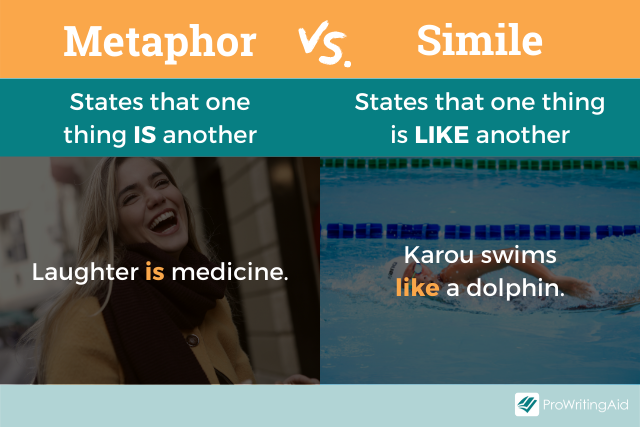
- Simile: Their relationship was like a tornado.
- Metaphor: Their relationship was a tornado.
Sometimes you might prefer the directness of a metaphor; other times a simile will carry your meaning more effectively. Some comparisons just work better as similes than metaphors and vice versa. Whatever works for your specific situation, metaphors and similes can bring creativity and intensity to your words and writing style.
Why Use Metaphors?
There are plenty of reasons to use metaphors in your work!
1. To Add Creativity
Writers want to express ideas creatively. They want to draw readers into experiences or emotions. They want to describe characters or scenes or events with originality to keep their readers engaged.

Sometimes, literal language just isn’t enough to get those jobs done. Or, maybe it can, but metaphor can do it better, with more intensity and vibrancy.
In Lucille Clifton’s poem “Miss Rosie,” the speaker, frustrated and angry by what Miss Rosie has become, calls her “you wet-brown bag of a woman.” I suppose the speaker could have said “Miss Rosie—you are useless” and still conveyed anger, but I doubt I would remember it. It’s kind of hard to forget that creative “wet-brown-bag” comparison.
2. To Bring Emotional Intensity
What statement conveys more feeling?
- I love you very much.
- My love for you is a raging fire.
Okay, perhaps my metaphor example is corny. But it is also more intense. Raging fire emphasizes the passion and heat and “out-of-controlness” that comes with being in love. It easily out-intensifies very much.
3. To Use the Power of Imagery
Each of the examples of metaphor used so far in this post have probably activated your senses. You can picture and perhaps even feel that cold heart of stone, or the pure, shining beauty of the heart of gold. You might have felt the heat of the fire and pictured its wild, red-hot flames.
4. To Provoke Thought
The meaning of a metaphor isn’t always glaringly obvious. You might have had to stop and think about the characteristics of a wet, brown bag before you could understand the speaker’s accusation in “Miss Rosie.” Once you stop and think, though, you can see the layers of meaning. A wet brown bag was once useful, but is now mushy, musty waste that’s good for nothing.
5. To Create Atmosphere
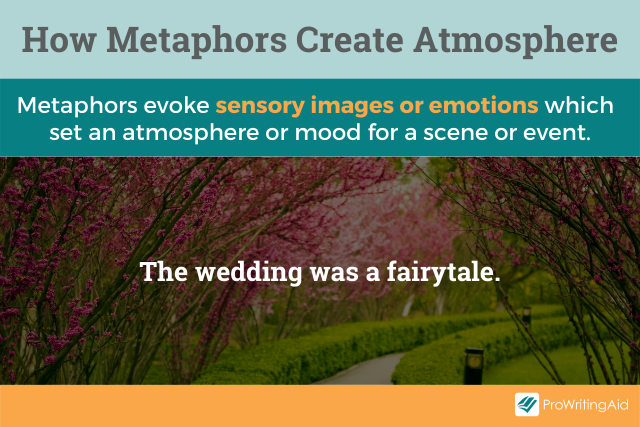
Sometimes, the sensory images or emotions evoked through metaphor can help set an atmosphere or mood for a scene or event, drawing audiences more deeply into the experience.
- The wedding was a fairytale.
The metaphor makes it easy to image a picture-perfect, enchanting celebration, full of happily-ever-after vibes.
- I finally found escape in the abandoned barn. The torrential rain was rapid machine-gun fire echoing threats of my destruction.
The metaphor adds to the danger of this moment. Not only has the person had to escape, but even the sound of the rain itself perpetuates the feeling that the character is under attack.
Examples of Types of Metaphors
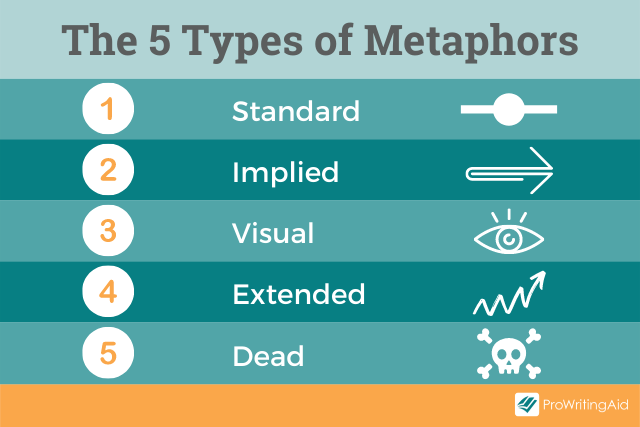
So far, the metaphors you’ve seen in this post have been standard metaphors. Standard metaphors simply make that direct comparison between two unlike things:
- Traffic was a beast today.
- That baby is a treasure!
However, standard is not the only type of metaphor. Here are some others:
Implied Metaphor
She hissed her warning— “Keep your mouth shut or I’ll shut it for you.”
In this case, no snake is mentioned, but the “hiss” implies the comparison of “she” to that dangerous, threatening creature.
Visual Metaphor
Visual metaphors show, rather than directly state, the comparison.
Does anyone remember the once-popular ad campaign that showed someone in a kitchen holding an egg and saying “this is your brain.” Then, the person cracked the egg into a hot pan, and as we watched that egg sizzle, said “This is your brain on drugs.”
Instead of directly saying, “drug use makes your brain a fried egg,” the campaign made a visual comparison.
Extended Metaphor
This term really defines itself! An extended metaphor is one that continues over multiple lines or stanzas of poetry, or sentences or paragraphs or segments of prose. Emily Dickinson’s poem “Hope is the Thing with Feathers'' is an example.
Dead Metaphor
A dead metaphor is one whose meaning, due to frequent use and/or the passage of time, has shifted or just lost its metaphorical power and become rather boring or cliche.
For example, some metaphors I’ve used in this post could be considered dead.
Heart of gold and heart of stone; love is a raging fire— these are metaphors that have lost some of their luster, maybe even prompt an eye roll, though we still understand their meanings.
If we call someone a laughing-stock, we mean the person is a fool, a joke, an embarrassment. But many who use the metaphor probably don’t know its likely origin, going back to the 1500s, when people were publicly punished and ridiculed by having their ankles and wrists locked into holes between two sliding boards—a contraption called “stocks.”
Thankfully, we don’t use that form of punishment anymore, but we have kept the metaphor.
What Is a Mixed Metaphor?
A mixed metaphor is a mistake. It occurs when a person combines elements of two unrelated metaphors to confusing, and often humorous, effect.
For example, we might call a person who is emotionally strong a tough cookie, which is itself an interesting (possibly dead) metaphor. What qualities does a cookie share with a strong person? I can’t find an origin story, but I’ll assume that it refers to a cookie that perhaps required a bit of effort to bite into.
If you say someone is not the sharpest knife in the drawer, you’re saying that they aren’t too smart. This metaphor’s meaning is easier to discern as “sharp” or “keen” are synonyms for “smart.”

But if you say a person is “not the toughest cookie in the drawer” you’ve just mixed your metaphors, and haven't really said much of anything—other than perhaps you need to “sharpen” yourself!
How to Use Metaphors in Your Writing
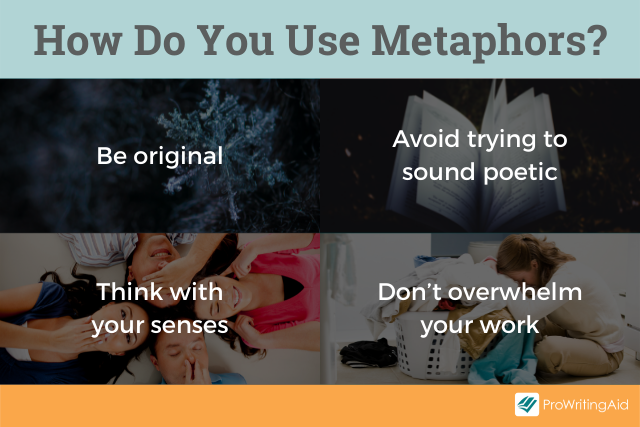
Don’t force metaphors or try too hard to sound “poetic.” Sometimes, the desire to be creative can lead you to produce overdone, overwrought, or overly complex metaphors. Remember, you want the metaphor to enhance the readers’ experience, not leave them frustrated and confused.
Think with your senses. Metaphors can create or deepen your work’s sensory effect. What metaphors can you use to intensify the sights, sounds, smells, tastes, or touch of your work?
Don’t overwhelm your work— especially prose—with metaphors. Metaphors are powerful figures of speech, but that doesn’t mean they should fill every line of your speech or text. Use metaphors thoughtfully and strategically in order to maintain their power and effect.
Be original. Avoid the cliches and stay away from often used images. For example, there are already plenty of love-compared-to-roses and snow-compared-to-blankets metaphors.
You might have to do some brainstorming. The first ideas that come to mind might be obvious because they’re common. Keep thinking. Check out ProWritingAid’s Clichés Report to look for these exhausted figures of speech. Then you can try to freshen them up with a new, creative metaphor!
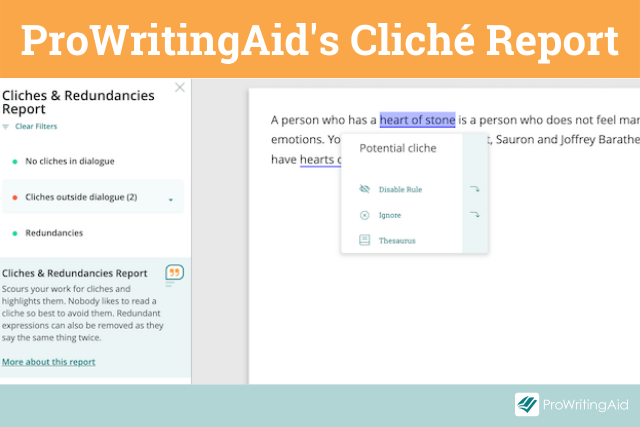
Sign up for a free account and try it for yourself.
Examples of Metaphors
Now that we know what a metaphor is, let’s take a closer look at some examples of metaphors at work in the real world.
Metaphor Examples from Literature
“The sun was a toddler insistently refusing to go to bed: It was past eight thirty and still light.”—Fault in Our Stars, John Green
“All the world’s a stage, and all the men and women merely players.”—As You Like It, William Shakespeare
“Her mouth was a fountain of delight.”—The Storm, Kate Chopin
“Life for me ain’t been no crystal stair.”—Mother to Son, Langston Hughes (the entire poem is an example of an extended metaphor)
“I’m a riddle in nine syllables”—Metaphors, Sylvia Plath (each line of the poem is a different metaphor, but the metaphors are all describing one thing.
“But, soft! What light through yonder window breaks? / It is the east, and Juliet is the sun.”—Romeo and Juliet, William Shakespeare
“The frosted wedding cake of the ceiling”—The Great Gatsby, F. Scott Fitzgerald
“Behind him, sitting on piles of scrap and rubble, was the blue kite. My key to Baba’s heart.”—The Kite Runner, Khaled Hosseini
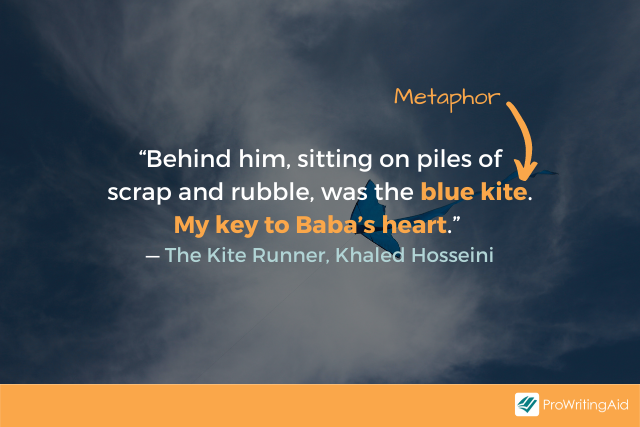
“This blood is a map of the road between us.”—Tear, Linda Hogan
“In her hands, I always became the pawn. I could only run away. And she was the queen, able to move in all directions, relentless in her pursuit, always able to find my weakest spots.”—The Joy Luck Club, Amy Tan
Metaphor Examples from Music
“Life is a highway / I wanna ride it all night long”—Tom Cochrane
“Baby you’re a firework!”—Katy Perry, Ester Dean, Stargate, Sandy Vee
“You are the thunder and I am the lightning”—Selena Gomez, Antonina Armato, Tim James, Devrim Karaoglu
“Love is a temple, Love a higher law”—U2
“You are the sunshine of my life”—Stevie Wonder
Metaphor Examples from Speeches or Famous Quotes
“I assume unhesitatingly the leadership of this great army of our people dedicated to a disciplined attack upon our common problems.”—Franklin D. Roosevelt, First Inaugural Address
"All religions, arts and sciences are branches of the same tree.”—Albert Einstein
“If this virus were a physical assailant, an unexpected and invisible mugger, which I can tell you from personal experience it is, then this is the moment we have begun together to wrestle it to the floor.”—Boris Johson qtd. in the Guardian
“But we refuse to believe that the bank of justice is bankrupt. We refuse to believe that there are insufficient funds in the great vaults of opportunity of this nation.”—Dr. Martin Luther King Jr., “I Have A Dream”
“What’s that got to do with women’s rights or negroes’ rights? If my cup won’t hold but a pint, and yours holds a quart, wouldn’t you be mean not to let me have my little half measure full?”—Sojourner Truth, “Ain’t I a Woman?”
Metaphor Examples from Advertising
- Budweiser is the “king” of beers
- Chevrolet is the “heartbeat” of America
- Exxon Oil used to tell drivers: “put a tiger in your tank!”
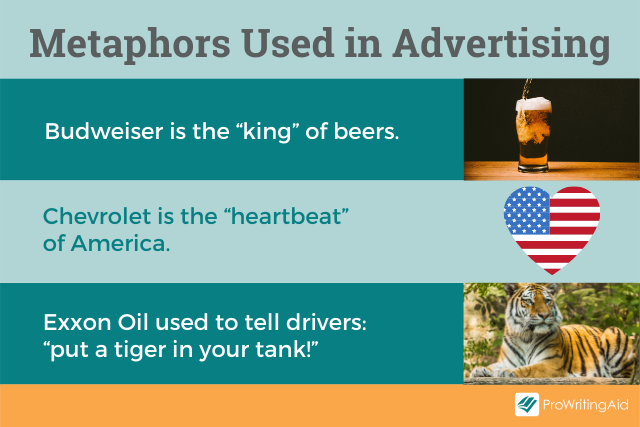
Why Metaphors Are Powerful
In her article “The Words that Help Us Understand the World,” Helene Schumacher says that metaphors “can explain complex concepts we may not be familiar with, help us to connect with each other, and can even shape our thought processes. They help us better understand our world.”
Author James Geary, quoted in the article, says “The only way we have of learning something new is by comparing it to something we already know.”
Metaphors bring to light something we had not perhaps considered or recognized. That something may be a depth of emotion, an insight. Whatever that “something” is, the metaphor delivers it in a unique, stirring way not matched by literal words alone.



